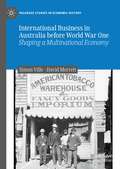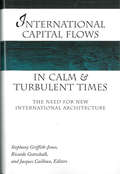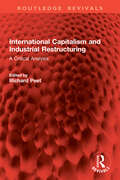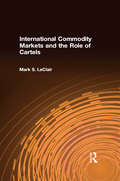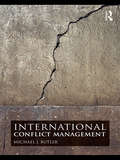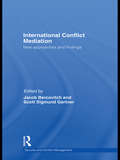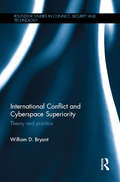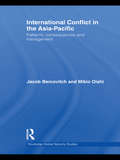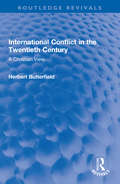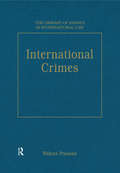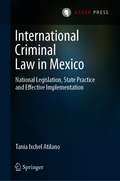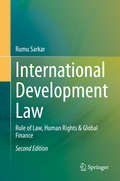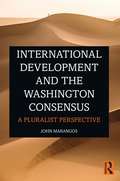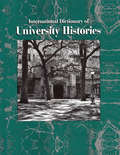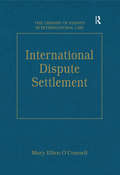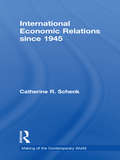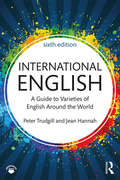- Table View
- List View
International Business in Australia before World War One: Shaping a Multinational Economy (Palgrave Studies in Economic History)
by Simon Ville David MerrettThis book challenges conventional wisdom by revealing an extensive and heterogeneous community of foreign businesses in Australia before 1914. Multinational enterprise arrived predominantly from Britain, but other sender nations included the USA, France, Germany, New Zealand, and Japan. Their firms spread out across Australia from mining and pastoral communities, to portside industries and CBD precincts, and they operated broadly across mining, trading, shipping, insurance, finance, and manufacturing. They were a remarkably diverse population of firms by size, organisational form, and longevity.This is a rare study of the impact of multinationals on a host nation, particularly before World War One, and that focuses on a successful resource-based economy. Deploying a database of more than 600 firms, supported by contemporary archives and publications, the work reveals how multinational influence was contested by domestic enterprise, other foreign firms, and the strategic investments of governments in network industries. Nonetheless, foreign agency – particularly investment, knowledge and entrepreneurship – mattered in the economic development of Australia in the nineteenth as well as the twentieth centuries. This book will be of interest to students and researchers in Australian and international economic and business history, the history of economic growth and scholars of international business.
International Capital Flows in Calm and Turbulent Times
by Stephany Griffith-Jones Ricardo Gottschalk Jacques CaillouxInternational Capital Flows in Calm and Turbulent Times analyzes the financial crises of the late 1990s and draws attention to the type of lenders and investors that triggered and deepened the crises. It concentrates on institutional investors and banks and provides detailed analysis of the countries most affected by the 1997-98 Asian financial crisis as well as the Czech Republic and Brazil. It also suggests necessary international financial reforms to make crises less likely. The book is unique in its scrutiny of the type of lenders and investors that triggered and deepened the crises, focusing particularly on institutional investors and banks; allocation of their assets; the criteria used in this process; and the impact of the nature of the investor on the volatility of different types of capital flow. It addresses such questions as: What determines or triggers massive changes in perceptions and sentiment by different investors and leaders? To what extent does contagion spread not just among countries but between actors? What are the policy implications of this analysis? The book concludes by examining the asymmetries in the financial architecture discussions and implementation and by offering policy proposals.
International Capitalism and Industrial Restructuring: A Critical Analysis (Routledge Revivals)
by Richard PeetFirst published in 1987, International Capitalism and Industrial Restructuring counters the idea that industrial restructuring is a relatively problem-free stage in the evolution to a post-industrial society. The editor argues that the permanent loss of eight million manufacturing jobs in the advanced industrial countries over the past ten years has had extremely serious effects on people, economies, and societies, and that it is a major cause of economic recession. The six million jobs gained in the newly industrializing countries pay low wages, expose workers to hazards, destroy local cultures, and fail in generating integrated development for the Third World.Many outstanding articles are included, drawn from a wide variety of radical journals, with introductions that set the scene and pose challenging questions. All students and researchers concerned with industrial restructuring in the capitalist world will find the book valuable as a radical critique of widespread current economic problems.
International Commodity Markets and the Role of Cartels (Issues In Work And Human Resources Ser.)
by Mark S. LeClairThe phenomenon of collusive international agreements (cartels) became widespread in the 1930s. At that time, attempts to control production and prices were mainly the prerogative of multinational firms operating in the developing (then colonized) world. The "modern era" of cartels began in the 1960s, when the governments of developing nations began to participate in commodity agreements to achieve increases and stability in the world price of their commodities. This book is principally concerned with the modern era of cartels. It goes beyond the singular example of petroleum and OPEC to examine the structure of international commodity markets for bauxite (aluminum ore), cocoa, coffee, rubber, sugar, and tin, and the conditions that led to the formation of cartels in those markets during the latter half of the twentieth century. Specifically, the work focuses on four major aspects of international commodity markets: patterns of production and consumption; economic dislocations to both importers and exporters due to price fluctuations; the formation of cartels as a solution to weak and variable commodity prices; and the likely effects arising from tightening raw material markets. The book concludes with a detailed examination of what the future holds for each of the cartels, and what role technology, 24-hour market trading, and decreasing foreign direct investment in producing countries will have on the management of commodity markets.
International Communism and the Spanish Civil War
by Lisa A. KirschenbaumInternational Communism and the Spanish Civil War provides an intimate picture of international communism in the Stalin era. Exploring the transnational exchanges that occurred in Soviet-structured spaces - from clandestine schools for training international revolutionaries in Moscow to the International Brigades in Spain - the book uncovers complex webs of interaction, at once personal and political, that linked international communists to one another and the Soviet Union. The Spanish Civil War, which coincided with the great purges in the Soviet Union, stands at the center of this grassroots history. For many international communists, the war came to define both their life histories and political commitments. In telling their individual stories, the book calls attention to a central paradox of Stalinism - the simultaneous celebration and suspicion of transnational interactions - and illuminates the appeal of a cause that promised solidarity even as it practiced terror.
International Competition and Strategic Response in the Textile Industries SInce 1870
by Mary B. RoseThis book of essays, which draws on the expertise of leading textile scholars in Britain and the United States, focuses on the problem of and responses to foreign competition in textiles from the late nineteenth century to the present day. A short introductory essay by the editor is followed by a survey of the debates surrounding the British cotton industry, foreign competition and competitive advantage. The other essays consider various aspects of that competition, including textile machine-making, Lancashire perceptions of the rise of Japan during the inter-war period and responses to foreign competition in the British cotton industry since 1945, whilst others deal with the decline and rise of merchanting in UK textiles and European competition in woollen yarn and cloth from 1870 to 1914. A recurring theme in a number of the essays is Japanese competitive advantage in textiles. The book is unique since although there are numerous books dealing with the problems of British staple industries, none focuses primarily on the issue of competition, its sources and responses, nor on textiles in general rather than a single industry. Moreover, since the scope is international rather than limited only to the UK, it follows recent trends in British busines history away from single company case studies towards a more thematic, comparative approach. In addition, the international authorship of these papers gives this book, first published in 1991, wide appeal.
International Conflict Management
by Michael J. ButlerThis new textbook provides students with an accessible overview of the logic, evolution, application and outcomes of the five major approaches of the growing field of international conflict management: traditional peacekeeping peace enforcement and support operations negotiation and bargaining mediation adjudication. The book aims to provide the student with a fuller understanding of the strengths and weaknesses of these five techniques within the dynamic context of the contemporary security environment, especially in relation to recent and ongoing case studies of inter-state and intra-state conflict. To demonstrate the changing nature of security in the post-Cold War world, the text contrasts this with competing visions of security during the Cold War and earlier periods, and provides numerous points of comparison with the dominant causes, types, strategy, and prosecution of warfare in other eras. International Conflict Management will be essential reading for all students of conflict management, mediation, peacekeeping, peace and conflict studies, and international security in general. Michael J. Butler is an Assistant Professor in the Department of Government and International Relations at Clark University (USA).
International Conflict Mediation: New Approaches and Findings (Routledge Studies in Security and Conflict Management)
by Jacob Bercovitch Scott Sigmund GartnerThis book examines how new empirical approaches to mediation can shed fresh light on the effectiveness of different patterns of conflict management, and offers guidelines on the process of international mediation. International conflict mediation has become one of, if not the most prominent and important conflict resolution methods of the early 21st century. This book argues that traditional approaches to mediation have been inadequate, and that in order to really understand how the process of international mediation works, studies need to operate within an explicit theoretical framework, adopt systematic empirical approaches and use a diversity of methods to identify critical interactions, contexts and relationships. This volume captures recent important changes in the field of international conflict mediation, and includes essays by leading scholars on a variety of critical aspects of conflict management, using state of the art analytical tools and up to date data. This book will of great interest to scholars of peace and conflict studies, methods in social science, and of International Relations in general.
International Conflict and Cyberspace Superiority: Theory and Practice (Routledge Studies in Conflict, Security and Technology)
by William D. BryantThis book examines cyberspace superiority in nation-state conflict from both a theoretical and a practical perspective. This volume analyses superiority concepts from the domains of land, maritime, and air to build a model that can be applied to cyberspace. Eight different cyberspace conflicts between nation states are examined and the resulting analysis is combined with theoretical concepts to present the reader with a conclusion. Case studies include the conflict between Russia and Estonia (2007), North Korea and the US and South Korea (2009) and Saudi Arabia and Iran in the Aramco attack (2012). The book uses these case studies to examine cyberspace superiority as an analytical framework to understand conflict in this domain between nation-states. Furthermore, the book makes the important distinction between local and universal domain superiority, and presents a unique model to relate this superiority in all domains, as well as a more detailed model of local superiority in cyberspace. Through examining the eight case studies, the book develops a rigorous system to measure the amount of cyberspace superiority achieved by a combatant in a conflict, and seeks to reveal if cyberspace superiority proves to be a significant advantage for military operations at the tactical, operational, and strategic levels. This book will be of much interest to students of cyber-conflict, strategic studies, national security, foreign policy and IR in general.
International Conflict in the Asia-Pacific: Patterns, Consequences and Management (Routledge Global Security Studies)
by Jacob Bercovitch Mikio OishiThis book analyses four major long-standing and intractable conflicts in the Asia-Pacific region (the Korean Peninsula; the Taiwan Strait; the South China Sea (Spratly Islands); and India-Pakistan), and aims to identify the mechanisms used to manage these conflicts. International Conflict in the Asia-Pacific brings together in one volume four major international conflicts that have shaped the region, and studies how they evolved and how best to manage them. The book seeks to find a pattern common to the four conflicts and their management as well as taking note of variations among them, hereby aiming to establish what might be called the 'Asia-Pacific way of managing intractable conflicts'. This book will of much interest to students of international conflict management, Asian politics, security studies and IR in general. Jacob Bercovitch is Professor of International Relations in the Political Science Department at the University of Canterbury in New Zealand. Widely regarded as one of the most influential scholars in the field of international conflict resolution, he is author of more than 15 books and numerous articles. Mikio Oishi is a Visiting Fellow with the National Centre for Peace and Conflict Studies (NCPACS), University of Otago and a Research Fellow with Political Science Programme of University of Canterbury.
International Conflict in the Twentieth Century: A Christian View (Routledge Revivals)
by Herbert ButterfieldFirst published in 1960, International Conflict in the Twentieth Century considers how to solve the problem of human relations for external affairs. Stepping back from the more common focus on "current affairs", the book explores in detail the processes and patterns of history, the principles that underlie foreign policy, the ethical issues involved in international affairs, and the role of Christianity in a time of global revolution. In doing so, it covers a variety of topics including morality, scientific approaches to politics, lessons from history, and human nature. International Conflict in the Twentieth Century will appeal to those with an interest in religion and politics, religious philosophy, and religious and political history.
International Crimes
by Gaurav SharmaThis volume makes accessible a selection of the most significant journal articles dealing with international crimes. The studies collected here will be an invaluable aid to teaching and research.
International Criminal Law in Mexico: National Legislation, State Practice and Effective Implementation
by Tania Ixchel AtilanoThis book puts forward proposals for solutions to the current gaps between the Mexican legal order and the norms and principles of international criminal law. Adequate legislative measures are suggested for compliance with international obligations. The author approaches the book's subject matter by tracing all norms related to the prosecution of core crimes and contextualizing each of the findings with a brief historical and political account. Additionally, state practice is analyzed, identifying patterns and inconsistencies. This approach is new in offering a wide perspective on international criminal law in Mexico. Relevant legal documents are analyzed and annexed in the book, providing the reader with a useful guide to the topics analyzed. Issues including the following are examined: the incorporation of core crimes in the Mexican legal order, military jurisdiction, the war crimes definition under Mexican law, unaddressed atrocities, state practice and future challenges to combat impunity. The book will be of relevance to legal scholars, students, practitioners of law and human rights advocates. It also offers interesting insights to political scientists, historians and journalists. Tania Ixchel Atilano has a Dr. Iur. from the Humboldt Universität Berlin, an LLM in German Law from the Ludwig Maximilian Universität, Munich, and attained her law degree at the ITAM in Mexico City.
International Debt
by Otto Hieronymi Constantine A. StephanouWritten by a group of international experts, this book focuses on three interdependent themes: (a) origins and consequences of the current debt crisis; (b) the systemic nature of the crisis; (c) national and international policy efforts to avoid a global collapse and bring about lasting reforms in the Euro zone and in the financial system.
International Development Law: Rule of Law, Human Rights & Global Finance (International Economic Development Law Ser. #Vol. 14)
by Rumu SarkarThis book describes how international development works, its shortcomings, its theoretical and practical foundations, along with prescriptions for the future. International Development Law provides the reader with new perspectives on the origins of global poverty, identifies legal impediments to sustainable economic growth, and provides a better understanding of the challenges faced by the international community in resolving global poverty issues. The text is structured into two basic parts: the first part deals with the theoretical and philosophic foundations of the subject, and the second part sets forth issues relating to the international financial architecture, namely, international borrowing practices, privatization, and emerging economies. In particular, the book provides new, innovative analysis on corruption as an impediment to sustainable development. The three interlocking facets of corruption are examined: transnational organized crime, Islamic-based international terrorism, and corruption within emerging economies and the international banking system. Thus fresh new analysis adds depth and clarity to a field that heretofore has been scattered and superficial. Finally, the “right to development” within the international human rights discourse is critically reviewed, particularly in light of new jurisprudence emerging from the African context.This book offers a fresh, new and balanced legal perspective on the development process. The text has been rigorously researched and has many practical facets based on the author’s professional experience within the international development field. It is an invaluable research and teaching tool since it takes a multidisciplinary approach to putting complex issues, legal trends and political questions into a clear, new perspective that is highly analytical as well as accessible to the reader. The author's elegant legal prose is both powerful and persuasive.
International Development Law: Rule of Law, Human Rights & Global Finance (Springer Textbooks in Law)
by Rumu SarkarThis textbook describes how international development functions, its shortcomings, its theoretical and practical foundations, along with prescriptions for the future. International Development Law provides students with new perspectives on the origins of global poverty, identifies legal impediments to sustainable economic growth, and provides a better understanding of the challenges faced by the international community in resolving global poverty issues. The text is structured into two basic parts: the first part deals with the theoretical and philosophic foundations of the subject, and the second part sets forth issues related to the international financial architecture, namely, international borrowing practices, privatization, and emerging economies. This book is a perfect teaching vehicle as it takes a multidisciplinary approach to addressing complex issues, legal trends and political questions into a clear, new perspective that is highly accessible to the reader.
International Development Organizations and Fragile States
by Marie Von EngelhardtThis book addresses a conundrum for the international development community: The law of development cooperation poses major constraints on delivering aid where it is needed most. The existence of a state with an effective government is a basic condition for the transfer of aid, making development cooperation with 'fragile' nations particularly challenging. The author explores how international organizations like the World Bank have responded by adopting formal and informal rules to engage specifically with countries with weak or no governments. Von Engelhardt provides a critical analysis of the discourse on fragile states and how it has shaped the policy decision-making of international organizations. By demonstrating how perceptions of fragility can have significant consequences both in practice and in law, the work challenges conventional research that dismisses state fragility as a phenomenon beyond law. It also argues that the legal parameters for effective global policy play a crucial role, and offers a fresh approach to a topic that is central to international security and development.
International Development and the Washington Consensus: A Pluralist Perspective
by John MarangosIn this book, John Marangos offers an insightful analytical and theoretical review of the Washington Consensus and its successors among the mainstream. Following an intuitive structure, it explores international development and the Washington Consensus, as a critique through the lenses of Neoclassical economics, Post Keynesian economics, Institutional economics, and Marxist economics. Ultimately, it provides a compelling alternative perspective to the dominant development paradigm, and enables readers to identify the interconnections, interrelationships, and intercontradictions between different frameworks and policies. It will be a valuable supplementary reading for students, researchers, and policymakers in international development, development economics, heterodox economics, and the history of economic thought.
International Dictionary of University Histories
by Carol Summerfield Mary Elizabeth DevineModeled on Fitzroy Dearborn's highly successful International Dictionary of Historic Places , the International Dictionary of University Histories provides basic information on 200 institutions--location, description, sources of further information--followed by an extensive 3000 to 5000 word essay on each university's history. Entries on each university conclude with a Further Reading list, and most entries are illustrated. Coverage is world-wide, and entries range from the great medieval institutions (Oxford, Heidelberg, the Sorbonne) to the great historic universities of the United States, to the newer universities of Australia and South Africa, to the lesser-known universities of India, China, and Japan. More than 200 writers, researchers and archival departments of the universities themselves have contributed to the Dictionary . Entries include those universities with the most fascinating histories and those that have played important roles in the development of their own countries and in the furtherance of world scholarship.
International Dispute Settlement
by Mary Ellen 0' ConnellThe very purpose of international law is the peaceful settlement of international disputes. Over centuries, states and more recently, organizations have created substantive rules and principles, as well as affiliated procedures, in the pursuit of the peaceful settlement of disputes. This volume of the Library of Essays in International Law focuses on the classic procedures of peaceful settlement: negotiation, good offices, inquiry, conciliation, arbitration, judicial settlement, and agencies for dispute resolution. The introduction provides a unique historic overview, explaining how the procedures first developed and changed over time. Each chapter features a seminal essay that helped create the changes described in the introduction. Being at the center of international law, dispute resolution has always been a core topic of international scholarship, this volume brings together for the first time, the pivotal writing in the field.
International Economic Integration in Historical Perspective (Routledge Explorations in Economic History)
by Dennis Patrick McCarthyInternational economic integration is not a recent phenomenon; its roots can be traced back to the Roman Empire. This informative volume departs from the conventional short-term analysis and takes a long-term view of the process, offering perspectives that are both detailed and diverse. Author Dennis McCarthy examines seven types of organizations that exemplify international economic integration (colonial empires, merchant associations, religious empires, criminal empires, free trade areas, customs unions and common markets), and representative examples of each type are analyzed in a comparative framework. Timely and unique, this book demonstrates that international economic integration is an economic and political process that also involves political economy. With an introduction defining key terms and concepts; a retrospective summarizing the main insights, and endnotes and a detailed bibliography offering readers ways to pursue these topics further, McCarthy’s book will prove indispensable to students and general readers who wish to gain a firm understanding of international economics and the processes that shape the world today.
International Economic Relations since 1945
by Catherine R. SchenkThe international economy since 1945 has endured dramatic changes in its balance of power, from the early period of prosperity for industrialised nations, to the 2008/9 global crisis. In this volume Catherine Schenk outlines these huge changes, examines how the world’s economic leaders have tried to organise and influence the international economy and presents the key frameworks in which international economic relations have developed. Focusing on the pattern of international trade, international investment and the changing organisation of the international monetary system, this volume takes a chronological approach of key time-frames, and shows how policy has impacted the balance of the international economy. Major events such as European integration in the 1960’s, the collapse of the international monetary system and oil crisis in the 1970’s the return of China to the international economy in the 1980’s and emerging market crises in the 1990s are discussed within the context of key themes including global economic and regulatory co-ordination, the role of American economic hegemony, the evolution of exchange rate policy and unequal development. International Economic Relations since 1945 is the perfect guide for all students of economic history and international history, and for those seeking to understand recent economic trends in a longer term perspective.
International Economic Relations since 1945 (The Making of the Contemporary World)
by Catherine R. SchenkThis second edition has been updated to include an assessment of economic relations up to the COVID-19 pandemic. It focuses on three main threads that tie national economies together: flows of goods, of people and of finance. Since the end of the Second World War, the international economy transformed from a tightly controlled trading system to the financial globalization of the late 20th century. This book traces the organisation of international economic relations from the 1944 Bretton Woods conference through to the 2008 financial crisis and its aftermath. By outlining the development of economic policy of both national and international institutions like the International Monetary Fund and the European Union, this volume examines how the global system was constructed and explores the sources of inequality and instability. The changing political context is also emphasised, especially the Cold War and its end, the rise of China and other emerging market economies and the prospect of a retreat from globalisation in the wake of the 2008 crisis. Using non-technical language and providing clear examples and evidence, the book is an accessible introduction to international economic relations that will be useful for all students of modern world history since 1945.
International Encyclopedia of Technical Analysis
by Jae K. Shim Joel G. Siegel Anique A. Qureshi Jeffrey BrauchlerInvestors are firmly entrenched in two camps: those who believe that economic and financial fundamentals are the keys to investment success, and those who prefer some form or other of technical analysis. To serve those who use technical analysis, the authors have written a practical, useful, and comprehensive guide to all the major and minor technical analysis systems used by today's investors and financial professionals. In this unique reference book, technical analysis systems are discussed in depth, with detailed attention to the pros and cons of each. In addition, the Encyclopedia offers a mini-dictionary of the terms, concepts, and market issues that are part of the discipline of technical analysis.
International English: A Guide to Varieties of English Around the World
by Peter Trudgill Jean HannahFrom Singapore to Scotland, Canada to the Channel Islands, Namibia to New Zealand and beyond, International English takes you on a fascinating journey through the varieties of English spoken around the world. Comparisons across the varieties provide a comprehensive guide to differences in phonetics, phonology, grammar and vocabulary, making this a useful resource for teachers of English as a foreign language and linguistics students alike. This sixth edition has been thoroughly updated to include the following: new sections on the Death of RP, Estuary English, Multicultural London English, the Dublin accent and Fijian English; updated material on RP phonology, New Zealand English phonology, Australian English lexis, North American English lexis and the Northern Cities Chain Shift; revised and updated references and bibliography. This textbook comes with free-to-download MP3 files at www.routledge.com/9781138233690, which demonstrate the different varieties featured in the book – ideal for use in class, at home or on the move. International English remains a key and indispensable resource for teachers and students, and is essential reading for anyone studying varieties of English in a global context.
